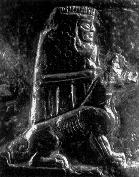The basenji dog is a primitive canid, genetically wolf-like and has gestation once per year rather than twice like most dogs; yet its tail curls up tightly unlike any wolf or other dog. New article about 93 cuniform clay tablets found at Bassetki, an ancient Assyrian trading center, mentions that one tablet referred to a goddess Gula, who was always depicted with her hound at her feet, which looks like a basenji with curled -up tail.
Bassetki ~ Basenji.
Assyrian cuneiform clay tablets as they were discovered inside a clay vessel at the Bronze Age city site of Bassetki (Mitanni-Assyrian, Kurdistan, North Iraq)
-
It is not yet known if the tablets contain business, legal, or religious records. "Our philologist Dr. Betina Faist has deciphered one small fragment of a clay tablet. It mentions a temple to the goddess Gula, suggesting that we may be looking at a religious context," he adds.
Goddess Gula and her dog:
https://www.google.com/search?
Picture of Basenji dog of Congo: http://dogtime.com/dog-
Do you agree that Gula's dog portrayed a Basenji, and that breed ended up in Congo with Bantu agriculturalists via trade, along with Asian domestic crops?
The intense work of reading and translating the 93 cuneiform tablets will begin in Germany
Read more at https://archaeologynewsnetw
In recent months, the researchers excavated layers of settlement dating from the Early, Middle, and Late Bronze Age, as well as from the subsequent Assyrian period. "Our finds provide evidence that this early urban center in northern Mesopotamia was settled almost continuously from approximately 3000 to 600 BCE. That indicates that Bassetki was of key significance on important trade routes," Pfälzner says.

-
It is not yet known if the tablets contain business, legal, or religious records. "Our philologist Dr. Betina Faist has deciphered one small fragment of a clay tablet. It mentions a temple to the goddess Gula, suggesting that we may be looking at a religious context," he adds.
Goddess Gula and her dog:
https://www.google.com/search?
Picture of Basenji dog of Congo: http://dogtime.com/dog-
Do you agree that Gula's dog portrayed a Basenji, and that breed ended up in Congo with Bantu agriculturalists via trade, along with Asian domestic crops?
The intense work of reading and translating the 93 cuneiform tablets will begin in Germany
Read more at https://archaeologynewsnetw
In recent months, the researchers excavated layers of settlement dating from the Early, Middle, and Late Bronze Age, as well as from the subsequent Assyrian period. "Our finds provide evidence that this early urban center in northern Mesopotamia was settled almost continuously from approximately 3000 to 600 BCE. That indicates that Bassetki was of key significance on important trade routes," Pfälzner says.

No comments:
Post a Comment